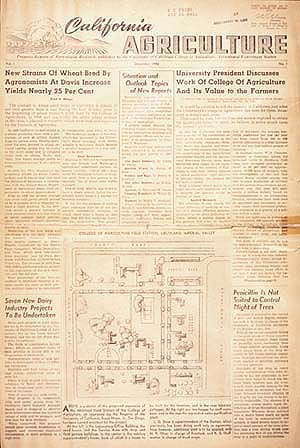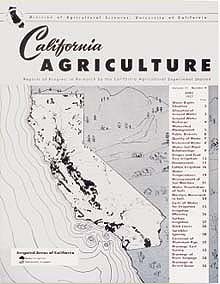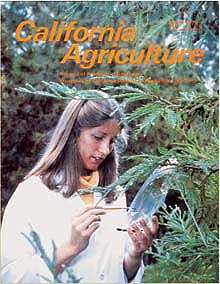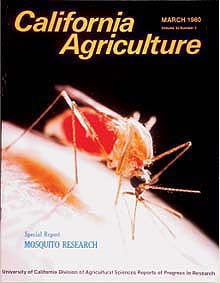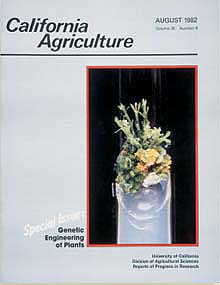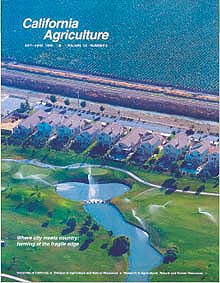All Issues
Celebrating a work in progress: UC journal delivers research to Golden State and beyond
Publication Information
California Agriculture 60(4):174-175.
Published October 01, 2006
PDF | Citation | Permissions
Full text
In the last 6 decades California Agriculture's format, length and design changed many times. As California grew and diversified, so did the journal. Today, published findings emanate from a broad band of disciplines, covering topics such as demographics, public policy and climate change.
However, our goals of publishing rigorously reviewed research, and translating that science for a diverse — and international — audience, are the same. California Agriculture is one of the nation's oldest, continuously published, land-grant university journals, and our presence extends beyond the printed page to our Web site, California Digital Library's eScholarship Repository and numerous scholarly databases. Below, a brief timeline of events:
December 1946: Publication of the first issue of California Agriculture, a four-page tabloid on newsprint.
1950s-1960s: In the early years, scientists report a growing diversity of findings, from the effectiveness of DDT, to attendant residue problems and increasing insect resistance. Other issues include some of the earliest reports on the rural-urban fringe problem (March 1959), integrated control (September 1960) and gamma ray research (March 1962).
April 1957: The first special issue appears, including 24 reports on the water situation.
January 1960: Research Briefs first published; these brief notes about UC research run occasionally through December 1978.
January 1969: The first editorial appears: “Research is People” by C.F. Kelly, then director, UC Agricultural Experiment Station.
September 1970: The first color cover appears, featuring rusty ribs of head lettuce. Color sections become regular in 1978, with the magazine adopting full color on all layouts by 1990.
1978: Peer review begins. At first this consists of a single reviewer for each article.
1981: The journal switches from monthly to bimonthly and now is longer, running 24 to 32 pages.
1970s-1980s: Content evolves in breadth and depth, embracing topics such as farmworkers and the wine industry (March-April 1989). The journal explores single subjects in greater depth, such as forestry (May 1979), mosquito research (March 1980) and genetic engineering (August 1982).
California Agriculture adopts desktop publishing soon after it becomes available in 1985.
1990s: More special issues appear, treating controversial subjects from diverse viewpoints. Special collections cover pesticides and food safety (May-June 1994), biodiversity (November-December 1995), hunger (December 1995), aquaculture and fisheries (July-August 1997) and urban encroachment on farmland (May-June 1998).
January 1992: Peer review is further strengthened with the establishment of the Associate Editor panel. The panel includes subject matter experts from within ANR who oversee the process; to be published, manuscripts must be accepted by at least two anonymous reviewers. Increasing requirements for long-term data and statistical analysis lead to lengthier articles and higher rejection rates (currently 25% or more).
The first market research begins in the form of a survey, to which 66% of readers respond.
1994: News sections are established to provide a real-world context for research articles. Front matter is brief and authored by editorial staff. Shortly after, the first Letters column appears.
December 1994: The journal begins listing references for further reading, and in May 1996 extensive use of references and citations begins.
January 1996:California Agriculture posts its first Web site, including tables of contents, news stories and research abstracts.
2000 and beyond: Growing emphasis on special collections with public policy implications, including grandparenting (March-April 2001), biotechnology and global warming (May-June 2002). In the Year 2000 series, scientists look at scenarios for the next 25 years in California, in the areas of demographics, natural resources, food production and food security (September-October 2000).
Also in 2000, California Agriculture begins posting the entire contents of the journal on the Web site, including full-text PDFs of peer-reviewed research articles.
2002:California Agriculture initiates continuous page numbering, a standard practice of peer-reviewed science journals.
January-March 2003: Due to the statewide budget deficit and UC cutbacks, the journal shifts to quarterly issues. Length of magazine increases to between 48 and 96 pages (i.e., Kearney at 40, April-June 2005).
August 2005: Double-blind procedures added to anonymous peer review. The journal begins requesting electronic submission of all new manuscripts.
April 2006:California Agriculture implements a new electronic peer-review system using Berkeley Electronic Press software, under contract with the California Digital Library (CDL). Prospective authors use the Repository's secure server to make submissions, upload revisions and check on the status of articles.
May 2006:California Agriculture begins posting all published, peer-reviewed articles to the CDL's eScholarship Repository. PDFs continue to be posted in full to the California Agriculture Web site.
— Editor




